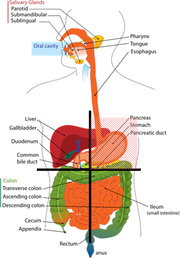
Left upper quadrant (abdomen)
Encyclopedia

Abbreviation
An abbreviation is a shortened form of a word or phrase. Usually, but not always, it consists of a letter or group of letters taken from the word or phrase...
as LUQ, is used to refer to a portion of the abdomen that allows doctor
Physician
A physician is a health care provider who practices the profession of medicine, which is concerned with promoting, maintaining or restoring human health through the study, diagnosis, and treatment of disease, injury and other physical and mental impairments...
s to localise pain and tenderness, scars, lumps and other items of interest. The LUQ extends from the median plane
Median plane
The median plane is a Midsagittal plane which bisects the body vertically through the navel, dividing the body exactly in left and right side.Sagittal plane is any plane parallel to the median plane....
to the left of the patient, and from the umbilical plane
Umbilical plane
The umbilical plane is the transverse plane passing through the umbilicus.This is similar to the location of the mid-transverse plane, which is the transverse plane made through the waist, into roughly two halves: the torso, arms and head on the top, and the pelvis and legs at the bottom. That is...
to the left ribcage.
The term is not used in comparative anatomy
Comparative anatomy
Comparative anatomy is the study of similarities and differences in the anatomy of organisms. It is closely related to evolutionary biology and phylogeny .-Description:...
, since most other animals do not stand erect. The equivalent term for animals is 'right anterior quadrant'.
Important organs
- StomachStomachThe stomach is a muscular, hollow, dilated part of the alimentary canal which functions as an important organ of the digestive tract in some animals, including vertebrates, echinoderms, insects , and molluscs. It is involved in the second phase of digestion, following mastication .The stomach is...
- SpleenSpleenThe spleen is an organ found in virtually all vertebrate animals with important roles in regard to red blood cells and the immune system. In humans, it is located in the left upper quadrant of the abdomen. It removes old red blood cells and holds a reserve of blood in case of hemorrhagic shock...
- Left lobe of liverLeft lobe of liverThe left lobe is smaller and more flattened than the right. It is situated in the epigastric and left hypochondriac regions. Its upper surface is slightly convex and is moulded on to the diaphragm; its under surface presents the gastric impression and omental tuberosity.-External links: - "The...
- Body of pancreasBody of pancreasThe body of the pancreas is a subsection of the pancreas organ in the human body. It is somewhat prismatic in shape, and has three surfaces: anterior, posterior, and inferior.It is at the same level as the transpyloric plane....
- Left kidneyKidneyThe kidneys, organs with several functions, serve essential regulatory roles in most animals, including vertebrates and some invertebrates. They are essential in the urinary system and also serve homeostatic functions such as the regulation of electrolytes, maintenance of acid–base balance, and...
and adrenal glandAdrenal glandIn mammals, the adrenal glands are endocrine glands that sit atop the kidneys; in humans, the right suprarenal gland is triangular shaped, while the left suprarenal gland is semilunar shaped... - Splenic flexureSplenic flexureThe splenic flexure is a sharp bend between the transverse and the descending colon in the left upper quadrant of humans. The left colic flexure is near the spleen, and hence called the splenic flexure. There are two colic flexures in the transverse colon — the other being the hepatic...
of colonColon (anatomy)The colon is the last part of the digestive system in most vertebrates; it extracts water and salt from solid wastes before they are eliminated from the body, and is the site in which flora-aided fermentation of unabsorbed material occurs. Unlike the small intestine, the colon does not play a... - Parts of transverseTransverse colonThe transverse colon, the longest and most movable part of the colon, passes with a downward convexity from the right hypochondrium region across the abdomen, opposite the confines of the epigastric and umbilical zones, into the left hypochondrium region, where it curves sharply on itself beneath...
and descending colonDescending colonThe descending colon of humans passes downward through the left hypochondrium and lumbar regions, along the lateral border of the left kidney....
Clinical significance
The LUQ may be painful and/or tender in such conditions as appendicitisAppendicitis
Appendicitis is a condition characterized by inflammation of the appendix. It is classified as a medical emergency and many cases require removal of the inflamed appendix, either by laparotomy or laparoscopy. Untreated, mortality is high, mainly because of the risk of rupture leading to...
, in case of intestinal malrotation
Intestinal malrotation
Intestinal malrotation is a congenital anomaly of rotation of the midgut...

